|
More Than Knots |
|
Turk’s Head Definition Page |
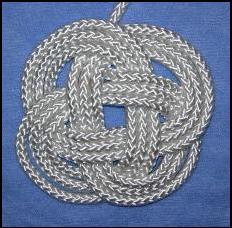
|
Definition of Turk's-Head knots: |
|
Quote from Ashley's Book of Knots, written by Clifford W. Ashley.
The Turk's-Head is a tubular knot that is usually made around a cylindrical object, such as a rope, a stanchion, or a rail. It is one of the varieties of the Binding Knot, and serves a great diversity of practical purposes but it is perhaps even more often used for decoration only; for which reason, it is usually classed with "fancy knots." Representations of the Turk's-Head are often carved in wood, ivory, bone, and stone.
Lever's Sheet Anchor (1808) states that a Turk's-Head, "worked with a logline, will form a kind of Crown or Turban." This resemblance to a turban presumably is responsible for the name "Turk's-Head." (End of quote.)
The Turk’s Head knots shown at the left are both the flat and cylindrical versions of a 3 lead by 4 bight knot. |
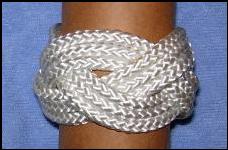
|
Naming Conventions: |
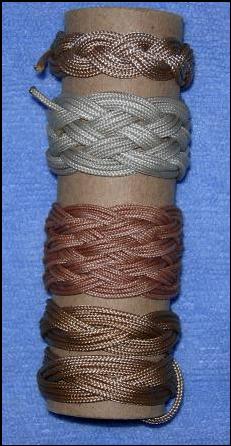
|
Turk's-Head knots received their name because they resemble a turban, however a turban is wound rather than interwoven. Turk's-Heads describe the family of all such knots rather than one such knot. Usually tied around a cylinder, the knot can also be tied in a flat decorative pattern, around a ball, and cruciform Turk's-Heads are tied in a cross shaped pattern.
Uses for the knot are usually decorative, however they can be used to mark the "helm is amidship" position of a ship's wheel or to tie off coach whipping or hitching work.
Turk's-Head knots are described by the number of interweavings called “Leads” (also called “Parts”; although not as common), the number of scallops around the edge called “bights”; and the number of times you have interwoven the knot called "passes". Usually the number of passes aren't relayed. So a three lead, four bight can be represented as 3L4B or 3L4B3P.
A cylinder with multiple Turk’s Head Knots is shown at the right. |
|
Sometimes they are described omitting the “L” and “B” designation, such as 3x4 to indicate the 3L4B designation. While the Turk's-Head is completed with one pass, usually two or three passes are completed to fill out the knot, make it more symetrical looking, or to strengthen the knot. While you may see some knots completed with more than three passes, as more passes are added, the knot becomes more difficult to tie. |
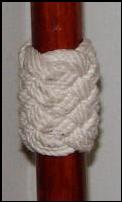
|
Methods of Tying: |
|
Turk's-Heads can be tied by several different methods. If tied while holding them in your hand, they are described as being tied "in hand". If a cylindrical form with pins is used this is "tying on a mandrel". And if a flat form or board with pins with used, this is tying with a board. Each method has it's advantages and disadvantages although it's almost impossible to tie the larger sizes without using a mandrel or a board. |
|
Turk's-Heads can also be tied in a flat pattern. In the knot shown at the left, this is a 3L4B Turk's head. When formed flat, it is called a Carrick Bend Mat. When "morphed" into a round pattern it is called the Boy Scout Woggle. So the name of the knot can change based upon the form it takes even though it is the same knot. |
|
Turk's-Heads can be expanded to make larger sizes. This is done by "splitting the leads". Once the initial pattern is followed, the tyer continues the knot going between two leads in a pattern that will increase the number of leads and bights on the knot thus expanding the knot. (Also called "raising the pattern" or "splitting the pairs".) Using this method a 3L2B expands to 5L4B, then 7L6B to 9L8B. Another sequence would be 4L3B - 6L5B - 8L7B - 10L9B. |
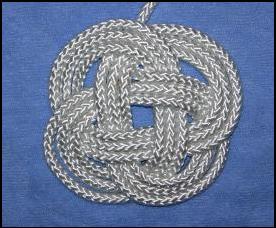

|
Some enthusiasts of Turk's-Head knots work on different patterns of Turk's-Heads almost exclusively. They have grouped the patterns into several types.
“Narrow”; where the number of leads is numerically two or more less than the number of bights, such as 3L5B or 5L7B.
“Wide”; where the number of leads is numerically two or more more than the number of bights, such as 5L3B or 16L7B.
“Square”; where there is only a numerical difference of one between the leads and bights, such as 3L4B or 5L4B.
“Cruciform”; Cross or T shaped Turk's-Heads. |